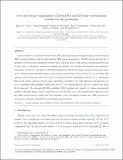Cost and energy requirements of hybrid RO and ED brine concentration systems for salt production
Author(s)
Fernandes, Jenifer; McCance, Adriene; Al-Anzi, Bader S.; Nayar, Kishor Govind; McGovern, Ronan Killian; Dominguez, Kyle P.; Lienhard, John H; ... Show more Show less
DownloadNayar et al. RO-ED Salt Production Final PrePrint.pdf (15.03Mb)
OPEN_ACCESS_POLICY
Open Access Policy
Creative Commons Attribution-Noncommercial-Share Alike
Terms of use
Metadata
Show full item recordAbstract
A new concept to concentrate seawater up to 200 g/kg for producing vacuum salt using a reverse osmosis (RO) system hybridized with an electrodialysis (ED) system is presented. The RO system operates up to pressures of 120 bar and concentrates seawater up to 120 g/kg with the ED system concentrating RO brine to 200 g/kg. A parametric analysis to minimize the specific cost of brine concentration was conducted. Parameters varied were: the degree of RO-ED hybridization, ED current density, electricity prices and water prices. Optimal hybrid RO-ED designs reduced brine concentration costs by 33–70% over standalone ED systems, with revenue generated from water co-production further subsidizing costs by 1–6%. Optimizing ED current density reduced costs the most. Including a crystallizer, the total reduction in production cost over a standalone ED-crystallizer system was 19–55%, with the production cost for a typical case being $111/tonne-salt. The proposed RO-ED-crystallizer (REC) systems were found to be techno-economically feasible in Cyprus, Japan, Kuwait, Saudi Arabia, and the USA. At a road transportation distance of 735 km, REC based seawater vacuum salt was competitive with conventional vacuum salt. REC systems may open up the potential of small-scale decentralized salt production. Keywords: Reverse osmosis; Electrodialysis; Hybrid; Salt production; Brine concentration; Seawater
Date issued
2019-01Department
Massachusetts Institute of Technology. Department of Mechanical Engineering; Sloan School of ManagementJournal
Desalination
Publisher
Elsevier
Citation
Nayar, Kishor G. et al. “Cost and Energy Requirements of Hybrid RO and ED Brine Concentration Systems for Salt Production.” Desalination 456 (April 2019): 97–120 © 2018 Elsevier B.V.
Version: Author's final manuscript
ISSN
0011-9164
1873-4464